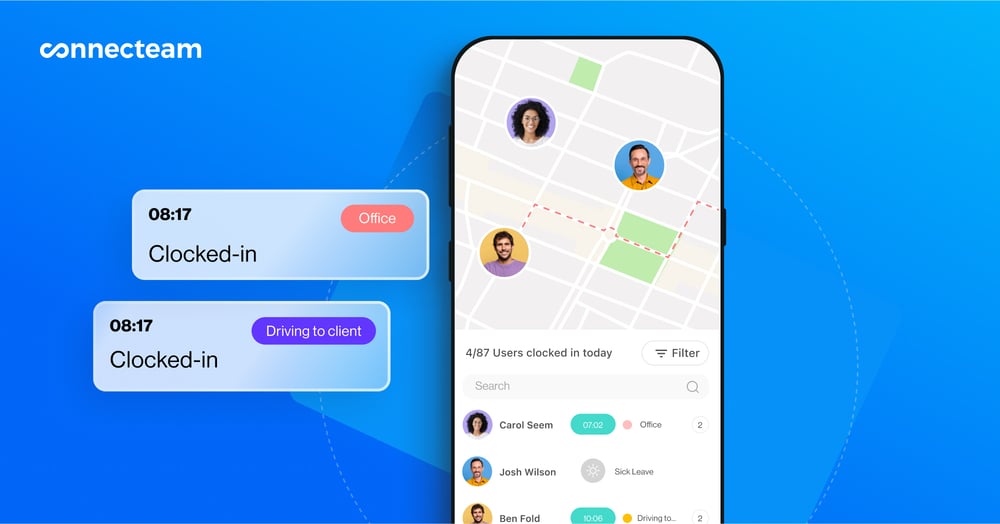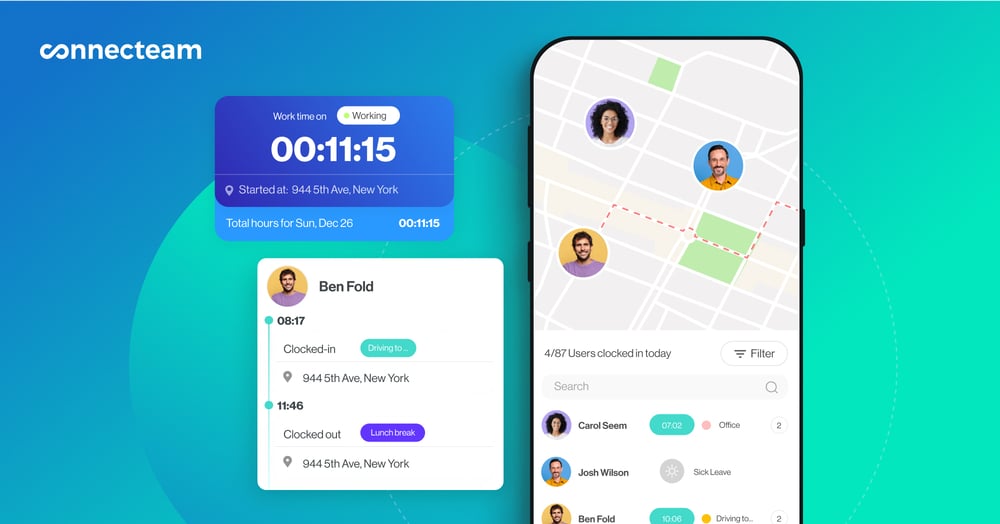In this guide, we explain what time card fraud is, whether it’s legal, and the 7 common types of time theft. We also share what to do if you believe an employee is lying on their time cards and how to prevent time card theft at your business.
From financial damage to employee distrust, time card fraud can pose a real threat to your business. But what exactly is time card fraud, and what does it look like in action? More importantly, how can you prevent it?
In the guide below, we provide all you need to know about time card fraud—whether you suspect someone has already stolen time from your company or simply want to avoid it becoming a problem. Read on to learn the different ways employees can commit time card fraud, how to protect your business, and the best way to record workers’ time accurately.
Key Takeaways
- Time card fraud happens when hourly employees “cheat the system” by changing their work hours to get paid more than they should.
- People can steal time in many ways, like pretending to work when they’re not, changing their hours on purpose, or having a friend punch in for them.
- There are no laws against time card fraud for private businesses in the United States, and it’s generally treated as a disciplinary issue.
- The exception is for US public government employees, who can face legal repercussions if they commit time card fraud.
- You can stop time card fraud by using software like Connecteam to track time accurately and ensuring workers take breaks and time off correctly.
What Is Time Card Fraud?
Time card fraud, sometimes called timesheet fraud, occurs when an employee misrepresents or manipulates their work hour records to earn money for time they didn’t work. It’s a serious ethical breach and, in most companies, a violation of workplace policies.
For employers like you, time clock fraud can cause significant financial losses and negatively impact the work environment by eroding employee trust. Workers may feel disengaged and upset if they learn their peers are participating in unfair practices. Plus, time card fraud can damage your company’s reputation in the industry if word spreads about the unethical behavior.
Is Time Theft Illegal?
Theft is a criminal act, but there are no specific time theft laws for private companies across the US. In most cases, time fraud is treated as an employee disciplinary issue rather than a crime. It’s unlikely an employee could go to jail for falsifying a time card unless the amount of paid time stolen significantly impacted the business.
Laws prohibiting time card fraud are limited to public government employees. These employees can be subject to a time card fraud felony or misdemeanor if they engage in significant time theft that defrauds the government.
There aren’t many situations where a US employer can successfully recover for time theft against an employee. According to the Society for Human Resource Management, a formal lawsuit is the only method for seeking recovery of stolen funds from time theft. However, these lawsuits don’t always have a high rate of success.
As an employer, you must be cautious not to engage in illegal behavior yourself if you find an employee has committed time theft. For instance, deducting improperly paid wages from an employee’s final paycheck could violate state or federal minimum wage laws.
9 Common Types of Time Card Fraud
Time card fraud can take many forms, but some common types include:
- Falsifying worked hours. Employees may manually adjust their time cards to show they worked more hours than they actually did.
- Lying about time cards. Employees who need an identification badge or swipe card to log into their time clock might lie about forgetting their card so they can manually enter a more favorable start time than when they arrived.
- Incorrectly logging breaks. An employee who intentionally fails to log out for a rest or lunch break might make it seem like they worked through the break or took a shorter break than they genuinely did.
- Misrepresenting time off. This can occur when an employee represents that they took fewer hours or days off than they did. As a result, the employee’s paid time off isn’t deducted, and they’re paid as though they worked for the time they didn’t.
- Buddy punching. This is where one worker clocks in or out for a colleague who isn’t present at the workplace.
- Clocking in when not working. Employees who manually record their work time or can clock in from any location may indicate they’re working while they’re away from the office or job site.
- Unauthorized overtime. Some employees might exaggerate the overtime they’ve worked to receive higher pay or benefits associated with extra hours.
- Manipulating digital time recordings. Employees with access to timekeeping systems might modify digital records to create the appearance of legitimate hours worked.
- Ghost employees. In larger organizations, there might be instances where non-existent employees are added to the payroll or terminated workers aren’t taken off it. Their pay is then diverted into someone else’s pocket.
What To Do If You Suspect an Employee Is Stealing Time
Step 1: Don’t jump to conclusions
Accusing an employee of time theft based on a rumor or gut feeling is never a good idea. Take the time to conduct an investigation until you can be sure improper behavior has occurred. To do so, follow steps 2 and 3 below.
Step 2: Review company policies
Re-familiarize yourself with your business’s policies regarding time theft, fraud, and disciplinary procedures. You can brush up on what does and doesn’t count as violating company rules, determine an appropriate course of action, and understand the potential consequences for the employee.
Step 3: Gather evidence
Next, gather concrete evidence of the suspected time theft. This could include discrepancies in timesheets, surveillance footage, witness accounts, or any other relevant documentation.
Keep detailed records of your investigation process, too. Record any interviews you conduct, store all your collected evidence, and create written documentation of your decisions. These records will be valuable if the situation escalates or you need to take legal action.
Step 4: Meet with the employee
If your investigation reveals strong evidence of time theft, schedule a private meeting with the employee. Follow your company policies and procedures for disciplinary meetings, as you may need to include additional parties like an HR or union representative.
During the meeting, present the evidence and allow the employee to explain their side of the story. While time theft is a serious offense, consider any extenuating circumstances that could have contributed to the employee’s behavior. Document their responses and keep a record of the conversation.
Step 5: Follow company procedures
Adhere to your company’s established procedures for addressing employee misconduct. You may need to coordinate with HR, executive leaders, or your legal department as necessary.
Step 6: Determine appropriate action
Based on the evidence, the employee’s explanation, and your company’s policies, decide on the appropriate action. This could range from a verbal warning up to termination, depending on the severity of the offense.
Once you’ve reached a decision, communicate the outcome to the employee clearly and respectfully. Consider meeting with them face-to-face if possible, and be sure to provide a written copy of the decision for their records.
If the worker’s employment will continue, explain how they should behave moving forward. Remind them of your company’s policies on time theft and detail what consequences they’ll face if they commit time card fraud again.
Learn how to write an employee disciplinary action form.
How To Accurately Track Employee Time and Prevent Fraud
One of the easiest and most effective ways to eliminate time card fraud in your business is to use time tracking software like Connecteam.
Our all-in-one employee management platform offers tools to track employees’ time automatically and accurately. Plus, there are several features to discourage time theft.

Connecteam’s standout features for time tracking include:
- Accurate time clock: Records workers’ hours to the second starting from the moment they punch in. Workers can punch in and out from their mobile devices with a single touch of their screen.
- Limits on clock-in and clock-out times: Adjust how early or late your workers can punch in and out each day. You can also prohibit early and late clock-in and clock-out altogether.
- Geofencing: Create virtual boundaries around your workplace to ensure employees are always on-site when they clock in and out.
- GPS location tracking: Records where an employee clocks in, tracks their location throughout their shift, and notes where they punch out. As a manager, you can see workers’ live locations anytime and check their location history for any given day.

- Unique login: Employees’ Connecteam accounts are linked to their phone numbers. This ensures clock-ins are legitimate and helps prevent buddy punching. You can also give workers personalized PIN codes if you use Connecteam as a kiosk app, where multiple employees clock in and out from a shared device.
- Automatic clock-out: Stop employees from staying past their shift end time to log extra minutes.
- Real-time notifications: Get alerts when employees enter unscheduled overtime, clock in late, attempt to punch in outside a geofence, fail to take a break, or are automatically clocked out.
- Customizable user permissions: Designate who can approve or modify time entries for better oversight.

- Customizable break, paid time off (PTO), and overtime rules: Create minimum and maximum amounts for each—including whether they’re paid or unpaid.
- Process time off requests: Employees can submit their own time off requests right in the app, and you can review them instantly. Connecteam will automatically add approved time off to workers’ time data.
- Automated timesheets: Connecteam will gather employees’ time entries and automatically generate digital timesheets you and your team can review. Export these to your payroll system or use one of Connecteam’s payroll software integrations for easy processing.
Beyond these features, Connecteam also has an in-app chat for real-time team communication, employee scheduling tools, and much more.
Get started with Connecteam for free today!
Did You Know?
A global study by the Association of Fraud Examiners found that payroll fraud was twice as likely to occur in small businesses than in large ones. That’s why it’s extra important for small business owners to prevent time theft. Thankfully, Connecteam makes this easy and affordable. Best of all: our Small Business Plan is free for life for up to 10 users!
The Bottom Line on Time Card Fraud
Time card fraud can occur in many circumstances, and it’s difficult to recover when an employee commits it. As an employer, you may feel frustrated and taken advantage of. Not to mention your finances can suffer, and team morale at your business can plummet.
To avoid time card fraud, ensure your employees track their time accurately and that you implement measures to prevent time theft. Using time tracking software like Connecteam is a great way to do this. However, if an employee does steal time from your company, follow the 6 steps outlined in this guide to handle the situation effectively.
FAQs
What can happen if you lie on a time card?
Lying on a time card is a form of time theft and can result in significant disciplinary action under most employment policies. It’s common for employees to get fired when their employer finds out about their actions.
Public government employees in the US can suffer more severe consequences. They may face a time card fraud felony and go to jail for falsifying a time card.
How serious is time card fraud?
Employees sometimes think exaggerating their time worked on timecards is a minor issue. This attitude can translate into serious financial repercussions for businesses that overpay. The best way to limit time card fraud is to use time and attendance software, such as Connecteam, with features to prevent time theft.



